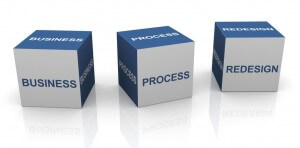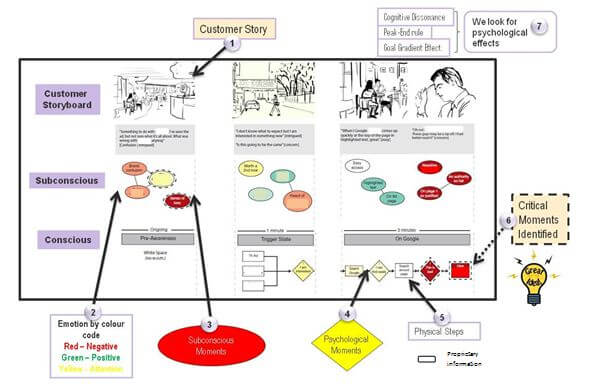By Steven Walden, VP Consulting and Thought-Leadership & Beth Coleman
Abstract
While Lean and Six Sigma ensure quality and sustained, measurable productivity, CEM-BPR enables break-through change, propelling the organization forward, to increase customer value, loyalty, and the maintenance and creation of competitive advantage.
Introduction
We all know Emotion is critical to how clients and consumers make decisions so where is emotion in your Business Process Redesign. If BPR purports to put the Customer first it must include the emotional view as well as one might add the subconscious view since emotions can also come from these types of experiences – think of call centre tone of voice.
The fact is however, they consider the emotional and subconscious view poorly if at all and certainly not written in Swim Lane diagrams that BPR engineers can understand!
It is no wonder then that the outcome of a redesign risks becoming a streamlined rational process that ignores the full customer experience. And at worst a cost-cutting exercise and as Hamel and Prahalad have said ‘You can’t shrink to greatness’.
Why Emotion is important in BPR
Let me give you a simple example of why any redesign must consider emotion.
In telecoms a company may measure Network and Voice Quality performance through internal metrics such as download speed and by asking the simple question of the customer are you satisfied with download speed. Here you can see high levels of satisfaction – it looks good.
No redesign required here…
Yet if we look at the emotional layer, the experience is decidedly bland. I might say I am satisfied or I recommend you on download speed but do I feel it!
Here an NEV score of 2% (see www.beyondphilosophy.com/blog/whats-your-companies-emotion-score) basically says there is very little difference between a customer’s negative and positive emotions towards this experience. The experience feels bland, customers don’t feel the quality, it doesn’t drive emotional value! And as we all know loyalty is an emotional commitment.
Here we would say there is a great redesign opportunity.
So… Now we get how important emotion is, how can we build the emotional view into BPR?
This we do with a process called CEM BPR (‘Customer Experience Management- Business Process Redesign’)
CEM-BPR Approach: mapping the customer’s psychology
Firstly, in CEM BPR we put our customer data into a Swim Lane format. A language BPR engineers can understand.
Here we illustrate 7 Swim Lanes.
CEM-BPR Swim Lanes
- The Customer Story – remember Customer is always at the top.
- Throughout the document we colour code emotion into the touchpoints so we can see at a glance the emotional colour of the experience – which also is an indicator of Mood by the length of colour expressed
- We identify subconscious moments – notice how they are non-linear
- We identify at the conscious layer, psychological moments i.e., the thoughts I have
- We identify the usual physical steps
- We identify the key critical moments
- We identify any important psychological effects – heuristics and biases such as the Peak-End rule
This truly is the full customer experience and critically acts as stimuli for great ideas in places we have never thought of before. Remember this is being used as a creative ‘ideas generation’ exercise not just about fixing breakages (see my blog on Creative Equity); ideas that are designed to be piloted.
At this point you may be asking yourself, well how do we know that these thoughts are thought or these emotions felt or subconscious experiences perceived. The answer lies in ‘expert judgement’ techniques and the intent of the research. As customers are not used to engaging in discussion at this level (and certainly not accurately outside the event because of post-hoc rationalisation), we ‘walk the experience of being the customer’, deliberately looking for the psychological moments. To do this we take a number of ‘walks’ by a small selection of ‘expert judgers’. We then consolidate the final map through agreement. This is a well established technique. The key dependency is on using people who are able to look for these psychological clues (i.e., with experience) and able to appreciate the ideas behind heuristics and biases (see Professor Kahneman).
Here we use what we call an Experience Psychology Checklist; for instance, with one client we noticed the ‘goal gradient effect’ with another the ‘affect heuristic’ and so forth.
CEM-BPR Swim Lanes: From ‘As Is’ to ‘To Be’
Once we have mapped the Customer’s full psychology we then co-create some to be ideas showing the evidence for change through the Swim Lanes. For instance here the reds turn to green positive emotional moments and the whole experience becomes streamlined to the customer.
Only then, when we have mapped out the customer story and identified the change ideas do we look at the internal Business Process.
By avoiding our internal maps until we have a great Customer Map we ensure that any internal process will be truly in support of the Customer. Now we can say forensically this is what the change is for the customer and this is the area of change inside our company to support this.
Ideas are then piloted in what we call Customer Lab. This is an important final point. The philosophy behind CEM-BPR is action orientated.
By doing and piloting change we:
- Encourage the culture ‘to action’– employees can see this is real and feel empowered ‘to do’
- Define quick wins – this shows leadership the returns
- Define mid and long term wins – setting out the strategy
- Identify areas of employee engagement – we can forensically identify opportunities for cultural, organizational and governance change that improve customer loyalty
Of course you may be asking yourself how do we know which of all the ideas will best deliver emotional value, beyond just saying so.
Well here we add in an additional often parallel step where we quantify the emotional –subconscious and rational touchpoint drivers of value using Emotional Signature®.
The Emotional Signature 3 Stroke Model
Using Emotional Signatures®, 3 stroke model of stimulus (the experience) – response (measured rational, emotional and subconscious consumer reactions) and effect on value we identify where we should place our emphasis on the redesign ideas for best quantified emotional return on say NPS® or CSAT (Emotional Satisfaction and Emotional NPS®). Or the best return overall (emotional-rational and subconscious).
We conclude with some comments on this approach from a leading BPR expert:
While Lean and Six Sigma ensure quality and sustained, measurable productivity, CEM-BPR enables break-through change, propelling the organization forward to increase customer value and loyalty, and maintain competitive advantage.
The as is – to be work that’s done in BPR (gap analysis) can become complicated unless there is a thorough analysis initially to define the areas of the business that could be re-designed. This is where the CEM-BPR method provides insights and opportunities that can precede the capturing of the as-is process to a detail level.
When a team has defined the process at a high level (ideally informed by an enterprise model) they can use the CEM-BPR analysis results to determine the processes that need to be mapped to a detailed level. With CEM-BPR, two gap analyses are required before preparation for the detailed BPR process re-design. The first is the as-is and to-be of the customer experience, followed by the helicopter view, process as-is and to-be design (informed by the CEM-BPR results). When the to-be of the integrated customer experience process map is defined, the project plan is finalized for a serious re-design project, at which time the hard work of mapping and designing the people, process and systems changes begins.
CEM-BPR is not a ‘service blueprint’ it is a ‘Customer Experience blueprint’.
|
|
Steven Walden is VP Consulting and Thought-Leadership for Beyond Philosophy. Steven has 17 years Strategy Consultancy experience directing and designing strategies for major B2C & B2B firms. At Beyond Philosophy, the Global Customer Experience Consultancy, he is a Thought Leader and Innovator, directing engagements to assist leading firms to transform through Customer Experience. A world-leader in emotional experience his skills lie in innovation, thought-leadership, strategy consultancy and Qual/ Quant research. He is a regular speaker at conferences, blog writer, CE Trainer and international author. |





